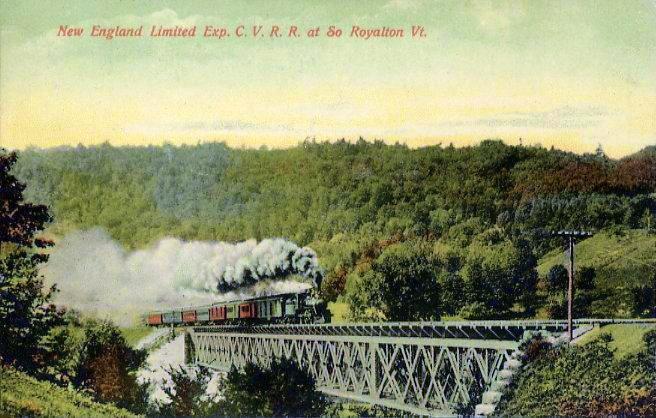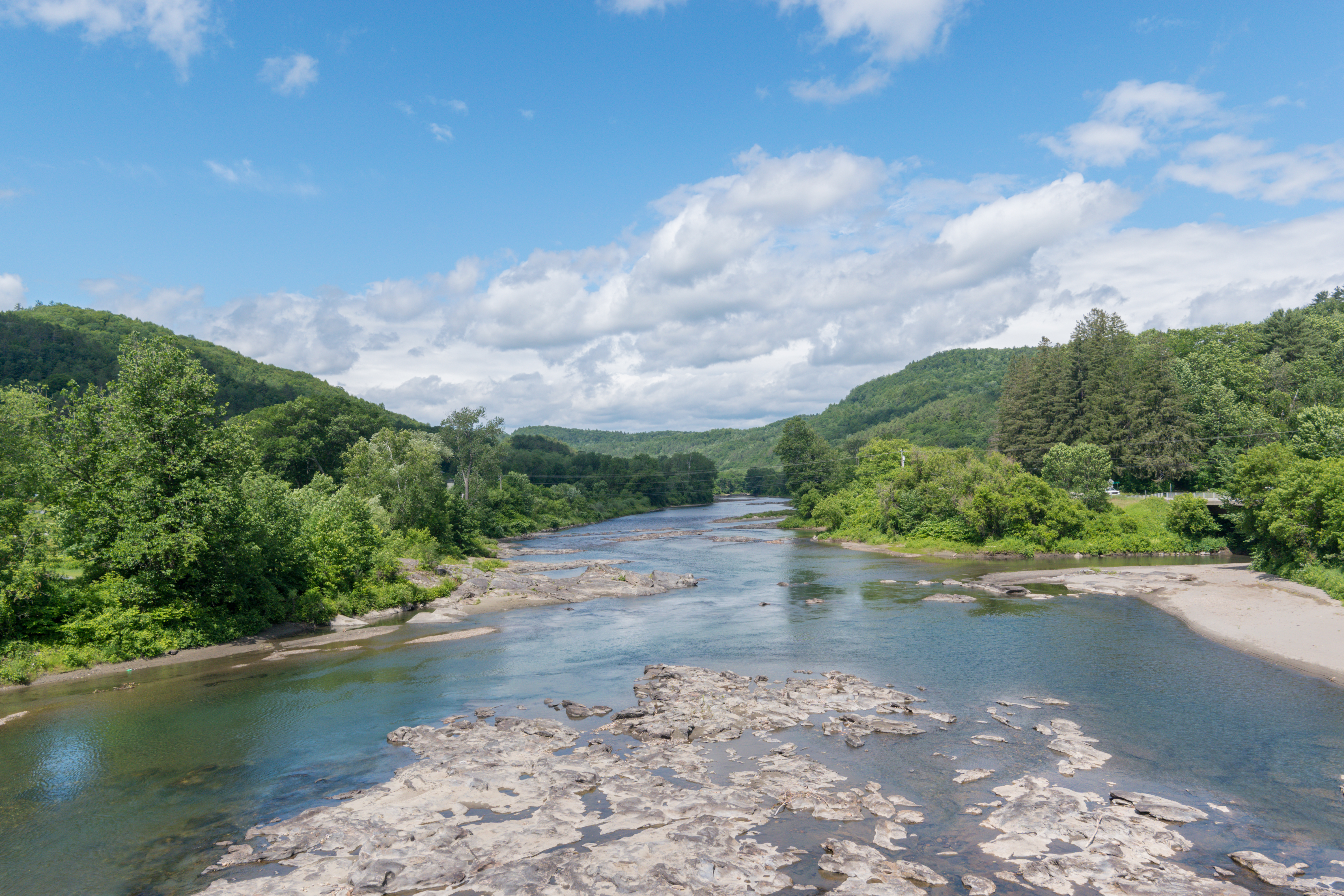|
White River Junction, Vermont
White River Junction is an unincorporated village and census-designated place (CDP) in the town of Hartford in Windsor County, Vermont, United States. The population was 2,528 at the 2020 census, up from 2,286 in 2010, making it the largest community within the town of Hartford. The village includes the White River Junction Historic District, a historic district listed on the National Register of Historic Places in 1980 and whose boundaries increased in 2002. The historic district reflects the urban architecture of the area from the late 19th century and early 20th century. The district is bounded by the Central Vermont railroad tracks, Gates Street, and South Main Street. It includes at least 29 contributing and non-contributing buildings. Notable buildings include the Coolidge Hotel, the First National Bank building, a U.S. Post Office building, and the White River Junction Fire House, showing examples of Greek Revival, Colonial Revival, Richardsonian Romanesque, Italianate, ... [...More Info...] [...Related Items...] OR: [Wikipedia] [Google] [Baidu] |
Census-designated Place
A census-designated place (CDP) is a Place (United States Census Bureau), concentration of population defined by the United States Census Bureau for statistical purposes only. CDPs have been used in each decennial census since 1980 as the counterparts of incorporated places, such as self-governing city (United States), cities, town (United States), towns, and village (United States), villages, for the purposes of gathering and correlating statistical data. CDPs are populated areas that generally include one officially designated but currently unincorporated area, unincorporated community, for which the CDP is named, plus surrounding inhabited countryside of varying dimensions and, occasionally, other, smaller unincorporated communities as well. CDPs include small rural communities, Edge city, edge cities, colonia (United States), colonias located along the Mexico–United States border, and unincorporated resort and retirement community, retirement communities and their environs. ... [...More Info...] [...Related Items...] OR: [Wikipedia] [Google] [Baidu] |
Vermont Central Railway
The Central Vermont Railway was a railroad that operated in the U.S. states of Connecticut, Massachusetts, New Hampshire, New York, and Vermont, as well as the Canadian province of Quebec. It connected Montreal, Quebec, with New London, Connecticut, using a route along the shores of Lake Champlain, through the Green Mountains and along the Connecticut River valley. It also connected Montreal to Boston, in eastern Massachusetts, through a junction with the Boston and Maine Railroad at White River Junction, Vermont. History The Vermont Central Railroad was chartered October 31, 1843, to build a line across the center of Vermont, running from Burlington on Lake Champlain east to the capital Montpelier, and then southeast and south to Windsor on the Connecticut River. Initial plans had the main line running through Montpelier. However, due to the difficulty of building through the Williamstown Gulf, a narrow valley south of Barre, Vermont, and to land interests of Charles Paine ... [...More Info...] [...Related Items...] OR: [Wikipedia] [Google] [Baidu] |
West Lebanon, New Hampshire
West Lebanon is an area within the city of Lebanon in Grafton County, New Hampshire, United States, along the Connecticut River. The ZIP Code area for the community had a population of 4,444 at the 2020 census, out of 14,282 in the entire city. West Lebanon contains a major commercial strip along New Hampshire Route 12A, serving the Upper Valley communities along Interstates 89 and 91. It also hosts the Lebanon Municipal Airport, a number of small software and tech businesses, and a regional daily newspaper, the ''Valley News''. The village serves as a bedroom community for nearby Dartmouth College. West Lebanon was the site of Lebanon's first settlement in 1761. The village later developed into a regional hub for rail transport, although at that time it was better known to travelers as Westboro. By the 1950s, however, the rail industry had shrunk significantly. The rail service through West Lebanon was eventually terminated, and the village of White River Junction, Vermont ... [...More Info...] [...Related Items...] OR: [Wikipedia] [Google] [Baidu] |
Connecticut River
The Connecticut River is the longest river in the New England region of the United States, flowing roughly southward for through four states. It rises 300 yards (270 m) south of the U.S. border with Quebec, Canada, and discharges into Long Island Sound between Old Saybrook, Connecticut, Old Saybrook and Old Lyme, Connecticut. Its watershed encompasses , covering parts of five U.S. states and one Canadian province, via 148 tributaries, 38 of which are major rivers. It produces 70% of Long Island Sound's fresh water, discharging at per second. The Connecticut River Valley is home to some of the northeastern United States' most productive farmland, as well as the Hartford–Springfield, Hartford–Springfield Knowledge Corridor, a metropolitan region of approximately two million people surrounding Springfield, Massachusetts, and Hartford, Connecticut. History The word "Connecticut" is a Corruption (linguistics), corruption of the Mohegan word ''quinetucket'' and Nipmuc word ''kw ... [...More Info...] [...Related Items...] OR: [Wikipedia] [Google] [Baidu] |
White River (Vermont)
The White River is a U.S. Geological Survey. National Hydrography Dataset high-resolution flowline dataThe National Map accessed April 1, 2011 river in the U.S. state of Vermont. It is a tributary of the Connecticut River, and the namesake of the White River Valley. The White River rises at Skylight Pond south of Bread Loaf Mountain near the crest of the Green Mountains. The river flows east to the town of Granville, Vermont, Granville, where it receives the outflow from the southern portion of Granville Notch. The river then turns south and, followed by Vermont Route 100, flows through the towns of Hancock, Vermont, Hancock and Rochester, Vermont, Rochester. Entering Stockbridge, Vermont, Stockbridge, the river turns northeast and, followed by Vermont Route 107, flows to the town of Bethel, Vermont, Bethel, where the Third Branch of the White River enters from the north. The Second Branch and the First Branch of the White River also enter from the north as the river flows throug ... [...More Info...] [...Related Items...] OR: [Wikipedia] [Google] [Baidu] |
Preserve America
Preserve America is a United States government program, established under President George W. Bush, intended to encourage and support community efforts to preserve and enjoy the country's cultural and natural heritage. As of 2017, more than 900 communities, representing all 50 states, Washington, D.C., American Samoa, and the U.S. Virgin Islands, have been designated as "Preserve America Communities".Overview Preserve America website, accessed August 17, 2008 Designated communities become eligible to apply for Preserve America grants to enhance and the use of community historic and cultural sites. Federal budget allocations for Preserve America grants totaled approximately $5 million in |
Junction (rail)
A junction, in the context of rail transport, is a place at which two or more rail routes converge or diverge. The physical connection between the tracks of the two routes (assuming they are of the same gauge) is provided by Railroad switch, turnouts (US: railroad switch, switches) and railway signalling, signalling. Overview In a simple case where two routes with one or two tracks each meet at a junction, a fairly simple layout of tracks suffices to allow trains to transfer from one route to the other. More complicated junctions are needed to permit trains to travel in either direction after joining the new route – for example by providing a triangular track layout.In this latter case, the three points of the triangle may be given different names, for example using points of the compass as well as the name of the overall place. Rail transport operations refer to railway station, stations that lie on or near a railway junction as a ''junction station''. In the UK it is customa ... [...More Info...] [...Related Items...] OR: [Wikipedia] [Google] [Baidu] |
Romanesque Revival Architecture
Romanesque Revival (or Neo-Romanesque) is a style of building employed beginning in the mid-19th century inspired by the 11th- and 12th-century Romanesque architecture. Unlike the historic Romanesque style, Romanesque Revival buildings tended to feature more simplified arches and windows than their historic counterparts. An early variety of Romanesque Revival style known as Rundbogenstil ("Round-arched style") was popular in German lands and in the German diaspora beginning in the 1830s. By far the most prominent and influential American architect working in a free "Romanesque" manner was Henry Hobson Richardson. In the United States, the style derived from examples set by him are termed Richardsonian Romanesque, of which not all are Romanesque Revival. Romanesque Revival is also sometimes referred to as the " Norman style" or " Lombard style", particularly in works published during the 19th century after variations of historic Romanesque that were developed by the Normans ... [...More Info...] [...Related Items...] OR: [Wikipedia] [Google] [Baidu] |
Italianate
The Italianate style was a distinct 19th-century phase in the history of Classical architecture. Like Palladianism and Neoclassicism, the Italianate style combined its inspiration from the models and architectural vocabulary of 16th-century Italian Renaissance architecture with picturesque aesthetics. The resulting style of architecture was essentially of its own time. "The backward look transforms its object," Siegfried Giedion wrote of historicist architectural styles; "every spectator at every period—at every moment, indeed—inevitably transforms the past according to his own nature." The Italianate style was first developed in Britain in about 1802 by John Nash, with the construction of Cronkhill in Shropshire. This small country house is generally accepted to be the first Italianate villa in England, from which is derived the Italianate architecture of the late Regency and early Victorian eras. The Italianate style was further developed and popularised by the arch ... [...More Info...] [...Related Items...] OR: [Wikipedia] [Google] [Baidu] |
Richardsonian Romanesque
Richardsonian Romanesque is a architectural style, style of Romanesque Revival architecture named after the American architect Henry Hobson Richardson (1838–1886). The revivalism (architecture), revival style incorporates 11th- and 12th-century southern French, Spanish, and Italian Romanesque architecture, Romanesque characteristics. Richardson first used elements of the style in his Richardson Olmsted Complex in Buffalo, New York, designed in 1870, and Trinity Church (Boston), Trinity Church in Boston is his most well-known example of this medieval revival style. Multiple architects followed in this style in the late 19th century; Richardsonian Romanesque later influenced modern styles of architecture as well. History and development This very free revivalism (architecture), revival style incorporates 11th and 12th century southern French, Spanish and Italian Romanesque architecture, Romanesque characteristics. It emphasizes clear, strong picturesque massing, round-headed "Ro ... [...More Info...] [...Related Items...] OR: [Wikipedia] [Google] [Baidu] |
Colonial Revival
The Colonial Revival architectural style seeks to revive elements of American colonial architecture. The beginnings of the Colonial Revival style are often attributed to the Centennial Exhibition of 1876, which reawakened Americans to the architectural traditions of their colonial past. Fairly small numbers of Colonial Revival homes were built –1910, a period when Queen Anne-style architecture was dominant in the United States. From 1910–1930, the Colonial Revival movement was ascendant, with about 40% of U.S. homes built in the Colonial Revival style. In the immediate post-war period (–early 1960s), Colonial Revival homes continued to be constructed, but in simplified form. In the present day, many New Traditional homes draw from Colonial Revival styles. Although associated with the architectural movement, "Colonial Revival" also refers to historic preservation, landscape architecture and garden design, and decorative arts movements that emulate or draw i ... [...More Info...] [...Related Items...] OR: [Wikipedia] [Google] [Baidu] |







